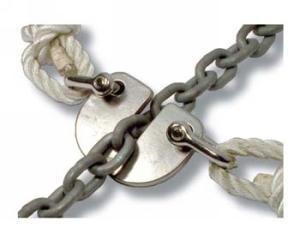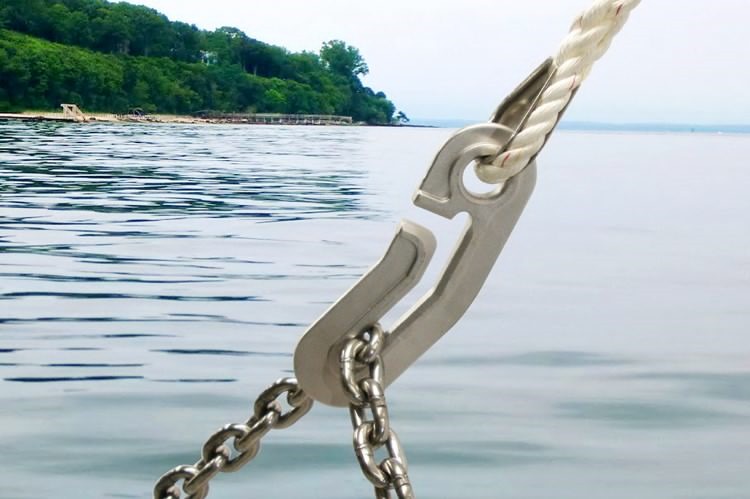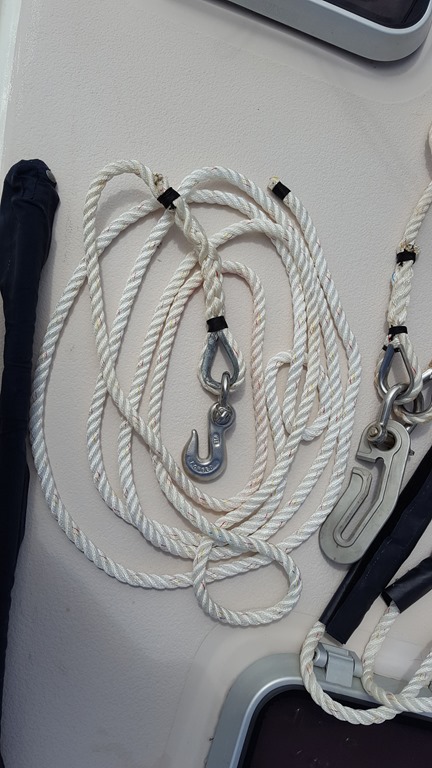Please see part one: “2016-05-13 Anchor Bridle–Storm Recap”
“THE SNUBBER — A snubber is simply a length of line used to take up strain on the anchor chain and acts as a shock absorber. When the wind is strong and pushing a boat back against it’s chain, higher peak loads are created that can cause the anchor to pull free; can cause serious damage to the boat’s windlass and fasteners; and may even damage interior joinery that the windlass is attached to. Also, the jerking motion can be extremely uncomfortable and noisy for those onboard.”
Prior to our January storm event we used the snubber depicted below. Having two lines cleated to the port and starboard bow cleats should always maintain a minimal strain on the chain to keep it secured to the bridle but making the bridle easy to remove in an emergency. We always left a great deal of slack in the chain causing the bridle plate to act as a cantilever with the chain draped over the ends. It clearly can be seen the safety provided by a quick release is also it failure point. We suspect our failure was both snubber lines became slack with the significant vertical motion of the bow the bridle was simply tossed off by the chain.
The settled upon solution perhaps goes to the other extreme in regards to maintaining a good connection to the chain. The “hook” is a Suncor Anchor Snubber purchased at Defender.com. The hook itself is made of 316 Stainless.
From the vendors website.
Magnolia’s implementation consists of the hook along with two 25ft – 1/2 inch 3 strand lines which I eye spliced over a stainless steel thimble. The Admiral made some easy to attach chaff guards out of “Shelter-Rite” attached using super strength velcro. I am monitoring the area near the thimbles for potential chaff from the chain but right now the chaff guards primarily intended for the deck chocks.
The second part of Magnolia’s implementation is a safety stop line incase the bridle fails. This is a standard 5/16th stainless chain hook also with 1/2 inch 3 strand line which I eye spliced over a stainless steel thimble.
Here the safety hook is attached to the chain and cleated to a bow cleat. This whole system I feel pushes the level of complication to a point where I may end up simplifying, perhaps by reducing the the snubber lines from two down to one. On the upside if we need to release the anchor in an emergency my trusty serrated line knife is always nearby! This is just the what we do aboard Magnolia. I am sure everyone has their own idea’s, this is just ours.







Nice post. Great setup.
Galvanized thimble? Why? In short order it will be a rusty mess.
The 2 on the bridle are stainless, need to get another for the safety line…could not get another stainless before underway.
Glad you guys made it through the derecho unscathed! We’ve been through a different one of those and it’s not fun! Just as food for thought, here is how we manage our anchoring system. We’ve made a few different decisions. Not better or worse, just different.
Our snubber is a 5/8″ 3 strand line with eye loops spliced into both ends and the middle marked with a thread. When we anchor, I simply tie a clove hitch around the chain in the middle of the snubber. Then the loop at each end of the snubber is dropped onto one of the bow cleats. The snubber is long enough to be just under the surface of the water. Then the anchor chain is let out to form a pretty good catenary loop.
Then I take the chain off the gypsy and wrap it around one of the bow cleats. That provides a safety in case the snubber breaks. And, like you, the bitter end is lashed onto an eye bolted inside the anchor well.
A couple points:
– our snubber is a little shorter and thicker than others. Using 3 strand and tying into the middle gives it enough stretch. At least it’s worked for us
– letting out more scope is a bit of a pain. I have to bring in the chain, untie the knot and then let out more. But it’s not too bad since a clove hitch never really tightens up too much
– in case of an emergency, I keep a second snubber in the anchor locker and just drop the first one into the water still tied onto the chain. Then tie the second one on at whatever new scope we decide on.
– I am a real fan of a knot instead of a mechanical hook. It eliminates lots of complications, can’t bounce off the chain, is easy to untie when retrieving and can’t come completely loose. It also provides instant backup because most likely failure point due to chafe is at the deck. If that happens, the knot and the other end of the snubber is still secure.
Hope this is at least a little clear and offers some food for thought. Would love to hear your feedback and thoughts!
Greg
S/V Paperbird
Pearson 422
http://www.paperbird.us
longsmail@paperbird.us
I am genuinely grateful to the holder of this site who has shared this enormous post at at this time.
You are most welcome